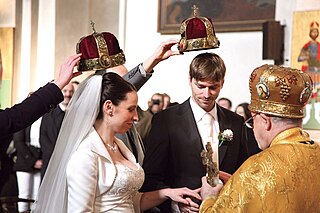Water into Wine refers to the transformation of water into wine at the wedding at Cana.
Water into Wine may also refer to:
Lock(s) may refer to:
Butt may refer to:
"Half and half" is the name of various beverages and foods made of an equal-parts mixture of two substances, including dairy products, alcoholic beverages, and soft drinks.

Cana of Galilee is the location of the Marriage at Cana, at which the miracle of turning water into wine took place in the Gospel of John.

The transformation of water into wine at the wedding at Cana is the first miracle attributed to Jesus in the Gospel of John, although none of the synoptic Gospels mentions the wedding at Cana.

A toast is a ritual during which a drink is taken as an expression of honor or goodwill. The term may be applied to the person or thing so honored, the drink taken, or the verbal expression accompanying the drink. Thus, a person could be "the toast of the evening", for whom someone "proposes a toast" to congratulate and for whom a third person "toasts" in agreement. The ritual forms the basis of the literary and performance genre, of which Mark Twain's "To the Babies" is a well-known example.
Canas or Cañas may refer to:
Trousseau may refer to:

John 2 is the second chapter of the Gospel of John in the New Testament of the Christian Bible. It contains the famous stories of the miracle of Jesus turning water into wine and Jesus expelling the money changers from the Temple.

The Wedding Feast at Cana, by Paolo Veronese, is a representational painting that depicts the biblical story of the Marriage at Cana, at which Jesus miraculously converts water into red wine. Executed in the Mannerist style (1520–1600) of the late Renaissance, the large-format oil painting comprehends the stylistic ideal of compositional harmony, as practised by the artists Leonardo, Raphael, and Michelangelo.

Marriage in the Eastern Orthodox Church is a holy mystery or sacrament in the Eastern Orthodox Church. The wedding itself is considered to be a rite of the church in which the marriage is blessed. Due to the practice of crowning the couple during the ceremony, the wedding is referred to as a "crowning" or "coronation", in reference to the wedding crown.
Pre-Cana is a course or consultation for couples preparing to be married in a Catholic church. The name is derived from John 2:1–12, the wedding feast at Cana in Galilee, where Jesus performed the miracle of turning water into wine.
CANA or Cana may refer to:
Caña may refer to:
Clarification, clarifications, or clarify may refer to:
Río Cañas is a river in Ponce, Puerto Rico. It is a tributary of the Río Matilde.
Cañas River may refer to:

The Wedding Church at Cana or simply Wedding Church, also Franciscan Wedding Church, is a religious building of the Catholic Church located in the central part of the town of Kafr Kanna (Cana), in Lower Galilee, located in northern Israel. It is dedicated to the weddings of Christianity. Its name commemorates the event of the Wedding at Cana from the Gospel of John, thought by some Christians to have taken place on the site, during which Jesus performed his first miracle, by turning water into wine at the request or behest of Mother Mary.

Wedding at Cana also known as Wedding Feast at Cana and Le Nozze di Cana is an oil painting by Michael Damaskinos. He was active during the second half of the 16th century in Heraklion, Sicily, Venice, and different parts of Italy. Over 100 works are attributed to the artist. Most of his work resembled the Greek mannerisms prevalent at the time also known as maniera greca. He was clearly influenced by Venetian painting. His version of the Wedding at Cana was a copy of Tintoretto's massive painting of the Wedding Feast at Cana. The monumental canvas was 4.4 m x 5.9 m or 14.4 ft x 19.3 ft. The painting was originally in the dining hall (refectory) of the convent of the Crociferi in Venice. Refectories typically featured large paintings of biblical banquet scenes. The monks preferred biblical banquet scenes because they desired the impression of dining with Christ. Damaskinos probably saw the painting at the convent or a copy of the masterpiece in Venice. The Damaskinos version is much smaller than the original. The painting is very important because it is one of the few instances where Damaskinos broke from the traditional maniera greca prevalent in most of his works. In this instance, he strictly followed the lines of Venetian painting exhibiting his superior craftsmanship as a painter capable of changing his style. El Greco was another painter who also painted in both styles. The Damaskinos version is currently at the Museo Correr in Venice, Italy.
The Wedding at Cana is a story in the bible.